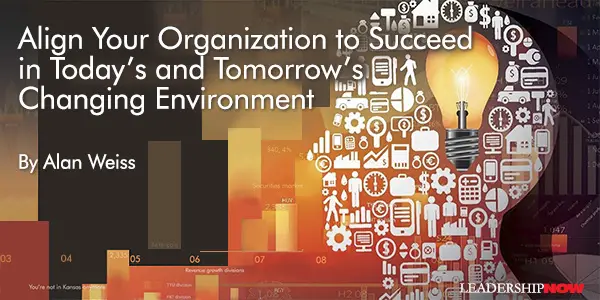 |
 |
05.05.23

Align Your Organization to Succeed in Today’s and Tomorrow’s Changing Environment
THE PANDEMIC threw all strategies into the junkyard. We now have the opportunity to deal with new realities, but that calls for an entirely new approach to half-century-old strategic processes. Conduct your “forensic implementation analysis” to examine these five dynamic forces: 1. Which Practices to Sustain In this dynamic, you are doing things today that will also serve you well in the future in achieving your vision. Ford’s F-150 pickup truck is the best-selling vehicle in the U.S. and has been for some time. It will probably maintain this status in the immediate future. Ford needs to sustain that type of vehicle and capabilities, whether powered by gas, batteries, hydrogen, or advertising heft. My landscaper has been working with different crews for the 30 years I’ve known him. He consistently sustains a scientific method about grass height, shrub diseases, removal of pests, and so forth. His equipment has changed as his crews have, but not the criteria he uses to keep the property looking great. 2. Which Practices to Improve You may currently be conducting business and engaging in actions that are working well now but won’t be for the future. You can build on their momentum by altering and changing them to maximize progress toward your vision. Championship golf courses use an architecture and difficulty that challenge the best in the world. But as the best keep getting better (improved equipment, better conditioning and strength, smarter course management, better coaches and caddies), it’s vital to improve the courses to meet the new abilities. Second and third cuts of growth may be made longer, bunkers deeper, and hold lengths extended. And the Professional Golf Association (PGA) also makes new rules to adjust to advances, including how many clubs players may carry and what kinds, the construction of the ball, and so forth. The improvements have to be consistent with an existing strength that required augmentation if it’s to remain effective in helping to drive the enterprise forward. 3. Which Practices to Jettison The poorest-run organizations refuse to fire people. Sometimes the excuse is legal concerns, and sometimes it’s someone in human resources trying to prove the department is actually important. Yet terminating poor performers is a service to the performer as much as to the organization. And too many organizations hold on to processes and procedures that not only will not help to reach the vision, but will usually impede progress. 4. Which New Practices to Retain Some adjustments due to the pandemic led to a great many new and effective practices — such as take-out food from high-end restaurants, virtual meetings, and heightened streaming entertainment. What we improvised for the moment should be analyzed as potential longer-term factors for success. You must identify those initiatives, innovations, and even behaviors that you may once have thought were temporary or ad hoc to deal with the pandemic but which are, in actuality, permanent advantages if you allow them to be. 5. Which Practices to Acquire The greatest innovations have come in times of war, pestilence, natural disaster, and so forth. Aside from weaponry, warfare created huge advances in medicine, trauma treatment, and communications. Moreover, innovation needs to be rather immediate. Strategically, you must look to acquisition in support for your strategic factors constantly, given changing times and priorities. You can’t look outside only when you’re failing inside! The point of your new strategic alignment is to ensure that you sustain your strengths, improve what is good but needs to be better, retain what you’ve created, jettison what will no longer support the organization, and acquire what’s missing to lead you toward your vision.  
Posted by Michael McKinney at 06:33 AM
|
BUILD YOUR KNOWLEDGE
 

How to Do Your Start-Up Right STRAIGHT TALK FOR START-UPS 
Grow Your Leadership Skills NEW AND UPCOMING LEADERSHIP BOOKS 
Leadership Minute BITE-SIZE CONCEPTS YOU CAN CHEW ON 
Classic Leadership Books BOOKS TO READ BEFORE YOU LEAD |